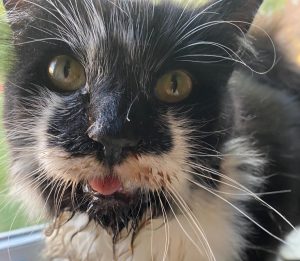
Heat stroke in cats
Overview
What is heat stroke in cats?
Symptoms
Risk
Diagnosis
Vet treatment
Prevention
When to worry

Heat stroke in cats
Heat stroke in cats is an extremely serious condition. It occurs when your cat’s internal body temperature is higher than normal. It is less common in cats compared to dogs, but they are still at risk.
Heat stroke requires immediate attention, or it can be fatal. If symptoms develop, remove your cat from the heat or sun, start cooling down, and contact your local vet. The most common cause is overheating during play or exercise. Heat stroke can also be known as hyperthermia, sunstroke, or heat-related illness.
What to do if your cat has heat stroke
Act calmly and quickly. With heat stroke, the faster the treatment, the more likely a full recovery is.
Stop any exercise and move immediately into a shaded and cool area.
Apply or spray cool water (tap water around 15-16℃) slowly on the body. Especially the tummy and inner thighs. You can use a cloth or towel to do this but do not leave the cloth on the body. Avoid the nose and mouth area.
Use a fan to cool or open all the windows to create a breeze.
Try to keep your cat as relaxed as possible, stress can worsen the problem.
Allow access to cool, fresh water for drinking.
Get your cat to your nearest vet practice as soon as possible. Make sure to use the air conditioning in the car or open all the windows.

What is heat stroke in cats?
Normal body temperature for cats should be between 38 and 39.2℃ (101-102.5℉). Heat stroke symptoms usually occur above 40℃.
The most common cause is overheating during play or exercise. It can also be caused by sitting in the sun or heat for too long. This can be outdoors, inside a vehicle, or in a building.
We mostly see this problem during the warm summer months, but it can happen at any time of the year.
A rise in body temperature can lead to serious damage to the internal organs. This can result in internal bleeding, coma, and death.
Immediate treatment is vital. The longer the body temperature is too high, the more damage there is to the body’s organs and tissues.
Heat stroke can affect cats of all ages, genders, and breeds. Brachycephalic (short-snouted) cats are much more likely to suffer from the condition.

Cats are different from humans in the way they cool themselves down. Instead of having sweat glands all over the body, they can only sweat through the paw pads. They cool down by cleaning themselves, shedding, and stretching out in cool areas. Heat stroke is not the same as having a high temperature or fever, which are normally due to infections.
Symptoms of heat stroke in cats
Your cat may show one, some, or all of the following signs of heat stroke:
Excessive panting or difficulty breathing
Drooling or foaming at the mouth
Shaking, agitation, or lethargy
Bright red or very pale gums
Reluctance to move, weakness, and muscle tremors
Confusion, seizures, loss of consciousness, or collapse

Are some cats more at risk of heat stroke than others?
The following traits may make your cat more susceptible to heat stroke:
Very young or older cats
Thick, long, or heavy fur
Underlying heart, lung, or airway problems, including feline asthma
Cats with paw pad disease
Particular breeds: Persians, Scottish Folds, and Himalayans
How is heat stroke diagnosed in cats?
Diagnosis is based on the symptoms and history of recent exercise or being in a warm environment.
A high temperature on arrival at the vet practice also confirms this diagnosis. This may not always be present if cooling treatment has been started at home.
What’s the treatment for heat stroke in cats?
If you suspect your cat has heat stroke, it is vital that you take them to your local vet for treatment immediately.
Further medications and treatments may be necessary depending on the symptoms:
Fluids via a drip help with cooling and protect vital organs.
Medications to stop any seizures.
Other treatments such as oxygen, sedation, tummy protectants, and antibiotics may be necessary.
Your cat may need to be hospitalised for several days. Once stable, they will be allowed home, but they will need careful monitoring. They may also need a repeat check with your local veterinarian.
Most mild cases should make a full recovery if treatment is started quickly.
How to help your cat stay cool and reduce the risk of heat stroke
Tips to help prevent heat stroke in cats
At homeEnsure constant access to multiple bowls of fresh drinking water. A water fountain can help encourage drinking.
Ensure they have access to a cool, shaded room.
Close the blinds and use fans or AC to improve ventilation.
Brush your cat daily. If your cat has a long or heavy coat, consider getting it clipped for the warmer months.
Add ice cubes to the drinking water and give frozen treats.
Get a cooling mat and place it in their favourite place to sleep.
Keep your cat in a healthy body condition. See our guide below.
Place any outdoor toys or beds in the shade.
Make sure they have constant access to fresh water.
Try to keep them indoors during the hottest time of day, close the blinds or use AC if you have it.
If your cat is at a higher risk, such as being elderly or having a heart condition, keep them indoors during the hot weather as long as it doesn’t cause stress.
Cats can die in hot cars, even with the windows open or in the shade.
Never leave your cat alone in the car.
Allow constant access to drinking water.
Keep windows open or the AC on.
Make sure your cat has a cool, shaded spot in the car while you are driving.
Avoid unnecessary travel, especially travelling during the hottest part of the day.
Our Joii team is here for you 24/7 with expert advice. If you have any questions about preventing heat stroke, don’t wait—reach out to us anytime!
When you should be worried about heat stroke in cats
Seek help immediately from a vet if your cat starts to show severe signs of heat stroke:
Difficulty breathing
Foaming at the mouth or bright red gums
Confusion, seizures and collapse
Speak to one of our Joii vets if:
Your cat has mild symptoms such as panting or low energy and you are unsure what to do.
Your cat has previously had heat stroke and you have any questions about it.
You need any advice about how to keep your cat cool in the warm weather.
You would like weight-loss advice for your cat.
Worried about your cats health? Try our free symptom checker to get instant insights and peace of mind!



















